History of the Royal Navy (before 1707)
 |
| His Majesty's Naval Service of the British Armed Forces |
|---|
| Components |
|
| History and future |
| Ships |
| Personnel |
|
| Auxiliary services |
The official history of the Royal Navy began with the establishment of the
Before the creation of the Royal Navy, the English navy had no defined moment of formation; it started out as a motley assortment of "King's ships" during the Middle Ages assembled only as needed and then dispersed, began to take shape as a standing navy during the 16th century, and became a regular establishment during the tumults of the 17th century.
England before 1603
Early English kingdoms
Some evidence of English ship construction in the
The threat from
The Danish "
United England (927–1066)
Naval operations are glimpsed again in 934, when
The renewal of serious Viking attacks in the reign of
English naval forces were supplemented by Scandinavian mercenaries. Directly after the fiasco of 1009 a new invasion force led by the Danish warlord
The early years of
In 1063 Earl Harold Godwinson led a fleet to Wales against Gruffydd ap Llywelyn of Gwynedd, while his brother Tostig invaded by land. Harold put Gruffydd to flight and destroyed his fleet and his residence at Rhuddlan, defeats which led to Gruffydd's murder by his own people in order to end the war. King Edward installed Gruffydd's half-brothers in his place, and they swore to serve him "on water and on land", suggesting that England's native naval forces could be supplemented by tributary contingents from neighbouring dependent territories as well as by foreign mercenaries.[13]
In 1066, following Edward's death and his own election as king, Harold assembled a powerful army and fleet in the
House of Normandy (1066–1135)
English naval power seemingly declined as a result of the
According to the Anglo-Saxon Chronicle, in 1068,
Though William the Conqueror caused a massive decline in English naval practices, he did occasionally assemble small fleets of ships, but only for limited activities. Most of these limited actions also did not involve direct combat at sea. An example of this was when the rebellious Anglo-Saxon Earl Morcar and his ally Bishop Æthelwine of Durham sought refuge on the Isle of Ely in 1071. According to Florence of Worcester reported, "The king [William the Conqueror] hearing of this, blocked up every outlet on the eastern side by means of boatmen [butescarls], and caused a bridge two miles long to be constructed on the western side." The Anglo-Saxon Chronicle also confirms these events. Though William used ships for blockading purposes and for important strategic engagements, his infrequent use of an established navy promoted a damaging practice of infrequent maritime operations, which his successors would practice on a frequent basis.[19]
House of Anjou (1154–1216)
In 1141
When King John’s campaign to recover Normandy from the French was at a breaking point, the northern barons of England began to rise in revolt. Forced by the insurrection, John signed Magna Carta on 15 June 1215, in hopes of satisfying the barons to buy time for Pope Innocent III to excommunicate the rebellious barons and condemn Magna Carta. From this, the barons revolted, commencing the First Barons' War with the capture of Rochester Castle. Grasping, however, that they (the barons) were outmatched by royalists and King John, the barons decided to turn to France for assistance. Realising the baron's intentions, John attempted to assemble a Navy, to prevent the arrival of the French.[21] France, who saw this as a fortunate opportunity, decided to assist the barons, with Phillip II's (King of France) son Dauphin Louis, later known as Louis VIII of France, to invade England. With John unable to swiftly build up his navy, due to the adopting of infrequent maritime operations from William the Conqueror, the French Navy under Louis invaded and landed at Sandwich unopposed in April 1216.[21] With Louis near London, John fled to Winchester, where he would stay until his death on 19 October 1216, having his nine-year-old son Henry III as heir to the throne.[22]
House of Plantagenet (1216–1399)
Paradoxically, John's death turned the tide against Louis, the rebellion in England, and the development of the English navy. William Marshal, 1st Earl of Pembroke, who became regent to the son of the recently deceased English king, began to regain the loyalties to the royalist cause through a regimen of compromise. Among these were the Cinque Ports, who had substantial amounts of maritime ships. With the English now having a substantial number of vessels, Louis returned to France to gather reinforcements and more maritime vessels. Though he succeeded, English vessels began to blockade and harass French shipping, trade, and blockaded multiple French-controlled English ports.[23]
By mid-1217, English royalists began to gain the advantage over the rebellious Barons and their French allies. Again needing more troops, Louis requested from his wife Blanche of Castile to assemble more troops for him. Up to the task, Blanche assisted in gathering forces for her husband, with a massive French force being assembled by August 1217, at the port of Calais. At the head of the French transports was Eustace the Monk, Louis’ best naval commander, who had helped Louis escape many English blockades, such as the one in Winchelsea in January 1217.[24]
The subsequent encounter between the two fleets came in the Downs off Sandwich, known as the Battle of Sandwich. For the first time in northern waters a decisive naval battle was fought on the open sea. The battle was dominated by the English, with French losing almost all of their ships, including Eustace the Monk who was killed in the action that took place. With the death of Eustace the Monk and the defeat of the French at Sandwich, William Marshal was able to isolate Louis in London, compelling him to renounce his claim to the English throne and force him to return to France.[25]
Later in the 13th century ships begin to be mentioned regularly as support for various campaigns under
In 1321 Sir
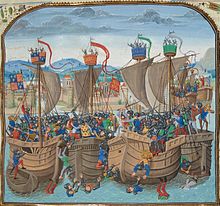
The
Houses of Lancaster and York (1399–1485)
Dealing with the matter of naval administration during the 15th century the most significant development was the establishment of the first Admiralty of England. This was brought about in 1412 when the remaining geographic 'admiralties' (the Northern Admiralty and Western Admiralty) were abolished and their functions were unified under a single administrative and operational command, the Admiralty Office, later called the Admiralty and Marine Affairs Office.[33]
There was no significant new construction until the 1480s, by which time ships mounted guns regularly; the Regent of 1487 had 225 serpentines, an early type of cannon. Henry VII deserves a large share of credit for the establishment of a standing navy. Although there is no evidence for a conscious change of policy, Henry soon embarked on a programme of building larger ships than previously. He also invested in dockyards, and commissioned the oldest surviving dry dock in 1495 at Portsmouth.[34]
House of Tudor, 1485–1603
The fleet began to increase in size under
In the year following the battle,
In the 1550s English gentlemen opposed to the Catholicism of Philip and Mary took refuge in France and were active in the English Channel as privateers under letters of marque from the French king. Six of their vessels were captured off Plymouth in July 1556.[39] In 1580 Spanish and Portuguese troops were sent to Ireland, but were defeated by an English army and naval force.[40]
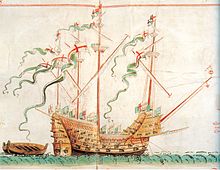 |
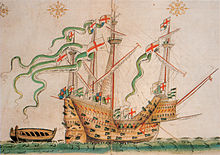 |
 |
 |
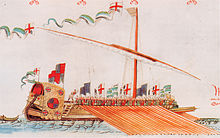 |
Spanish Armada (1588) and English Armada (1589)

While Henry VIII had launched the Royal Navy, his successors Edward VI and Mary I had neglected it, and it was little more than a system of coastal defence. Elizabeth made naval strength a high priority.[39][41] She risked war with Spain by supporting the "Sea Dogs", such as John Hawkins and Francis Drake, who preyed on the Spanish merchant ships carrying gold and silver from the New World. The Navy yards were leaders in technical innovation, and the captains devised new tactics. Parker (1996) argues that the full-rigged ship was one of the greatest technological advances of the century, and permanently transformed naval warfare. In 1573 English shipwrights introduced designs, first demonstrated in the Dreadnaught, that allowed the ships to sail faster and manoeuvre better, and permitted heavier guns.[42] Whereas before warships had tried to grapple with each other so that soldiers could board the enemy ship, now they stood off and fired broadsides that would sink the enemy vessel.[43]
Under

The Armada was first sighted by the English off Lizard Point, in Cornwall, on 19 July, and the first engagement took place off Plymouth on 21 July. In four hours the Spanish fired 720 round shot and the English 2,000 rounds, but little real damage was done to either side.[46] In fighting off Portland Bill on 23 July, some 5,000 shots were discharged by the rival fleets. Spanish casualties were about 50 killed and 70 wounded.[47] After another engagement off the Isle of Wight on 24 July, in which the Armada lost another 50 men slain, Medina Sedonia steered for Calais to replenish his empty powder and shot stocks from Parma's ammunition depots. Parma, however, blockaded in Bruges by 60 Dutch ships, was unable to come to the Armada's assistance. After an indecisive engagement with the English off Gravelines, the Armada ran out of ammunition. The Spanish had expended 125,000 cannonballs against the English. Consequently, the Spanish commander decided to retreat to Spain by going north around Scotland and Ireland. The Spanish ships were dispersed by storms; their provisions gave out, and many of those who landed in Ireland were killed by English troops. Only about half the fleet reached home. An English Armada sent to destroy the port at A Coruña and land in Lisbon in 1589 was itself defeated with 40 ships sunk and 15,000 men lost.[48] The Spanish victory marked a revival of Philip II's naval power through the next decade.[49] In October 1596, another Armada left Lisbon. The invasion fleet numbered 126 ships and carried 9,000 Spaniards and 3,000 Portuguese. The Royal Navy was unprepared, but England was saved by stormy seas that wrecked 72 ships and drowned 3,000 sailors and soldiers.[50] The following year, in October 1597, yet another Armada was sent out, but this also was blown back.[51]
The destruction of the Spanish Armada marked the high point of Elizabeth's reign, but the loss of the English Armada (or Counter Armada) the following year discouraged further joint stock adventures on such a scale.[52][53] Technically, the Spanish Armada failed because Spain's over-complex strategy required coordination between the invasion fleet and the Spanish army on shore. But the poor design of the Spanish cannons meant they were much slower in reloading in a close-range battle, allowing England to take control. Spain and France still had stronger fleets, but England was catching up.[54][55]
Scotland before 1603

The Royal Scots Navy (or Old Scots Navy) was the navy of the Kingdom of Scotland until its merger with the Kingdom of England's Royal Navy in 1707 as a consequence of the Treaty of Union and the Acts of Union that ratified it. From 1603 until 1707, the Royal Scots Navy and England's Royal Navy were organised as one force, though not formally merged.[56]
There are mentions in medieval records of fleets commanded by Scottish kings including
English naval power was vital to King
After the establishment of Scottish independence, King
King
James IV put the Royal Scots Navy on a new footing, founding a harbour at Newhaven in May 1504, and two years later ordering the construction of a dockyard at the Pools of Airth. The upper reaches of the Forth were protected by new fortifications on Inchgarvie.[69] Scottish ships had some success against privateers, accompanied the king in his expeditions in the islands and intervened in conflicts in Scandinavia and the Baltic Sea.[64] Expeditions to the Highlands to Islands to curb the power of the MacDonald Lord of the Isles were largely ineffective until in 1504 the king accompanied a squadron under Wood heavily armed with artillery, which battered the MacDonald strongholds into submission. Since some of these island fortresses could only be attacked from seaward, naval historian N. A. M. Rodger has suggested this may have marked the end of medieval naval warfare in the British Isles, ushering in a new tradition of artillery warfare.[66] The king acquired a total of 38 ships for the Royal Scottish Navy, including Margaret, and the carrack Michael or Great Michael, the largest warship of its time (1511).[70] The latter, built at great expense at Newhaven and launched in 1511, was 240 feet (73 m) in length, weighed 1,000 tons, had 24 cannon, and was, at that time, the largest ship in Europe.[70][71] It marked a shift in design as it was crafted specifically to carry a main armament of heavy artillery.[66]

During the Rough Wooing, the attempt to force a marriage between James V's heir
When, as a result of the series of international treaties, Charles V declared war upon Scotland in 1544, the Scots were able to engage in a highly profitable campaign of privateering that lasted six years and the gains of which probably outweighed the losses in trade with the Low Countries.[74]
The Scots operated in the
The Scottish Reformation in 1560 established a government that was friendly to England and this resulted in less military necessity to maintain a fleet of great ships. With the Union of the Crowns in 1603, the incentive to rebuild a separate royal fleet for Scotland diminished further since James VI now controlled the powerful English Royal Navy, which could send ships north to defend Scottish interests, and which now opened its ranks to Scottish officers.[79]
After Union of the Crowns, 1603–1707

After 1603 the English and Scottish fleets were organised together under
During the early 17th century, England's relative naval power deteriorated, and there were increasing raids by
Charles I (1625–1649)
In the 1620s, Scotland found herself fighting a naval war as England's ally, first
Charles I levied "ship money" from 1634 and this unpopular tax was one of the main causes of the first English Civil War from 1642–45. At the beginning of the war the navy, then consisting of 35 vessels, sided with Parliament. During the war the royalist side used a number of small ships to blockade ports and for supplying their own armies. These were afterwards combined into a single force. Charles had surrendered to the Scots and conspired with them to invade England during the second English Civil War of 1648–51. In 1648 part of the Parliamentary fleet mutinied and joined the Royalist side. However, the Royalist fleet was driven to Spain and destroyed during the Commonwealth period by Robert Blake.[90]
Commonwealth (1649–1660)
The Interregnum saw a considerable expansion in the strength of the navy, both in number of ships and in internal importance within English policy. The execution of Charles I forced the rapid expansion of the navy, by multiplying England's actual and potential enemies, and many vessels were constructed from the 1650s onward under a reformed institution.
The Commonwealth's introduction of

Restoration (1660–1688)
In 1664 the English captured
As a result of their defeat in the First Anglo-Dutch War, the Dutch transformed their navy, largely abandoning the use of militarised merchantmen and establishing a fleet composed mainly of heavily armed, purpose-built warships, as the English had done previously. Consequently, the
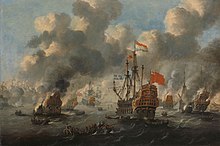
During the 1670s and 1680s, the English Royal Navy succeeded in permanently ending the threat to English shipping from the Barbary corsairs, inflicting defeats which induced the Barbary states to conclude long-lasting peace treaties.
Glorious Revolution and capture of Gibraltar 1688–1707
The
By 1697 the English Royal Navy had 323 warships, while Scotland was still dependent on merchantman and privateers. In the 1690s, two separate schemes for larger naval forces were put in motion. As usual, the larger part was played by the merchant community rather than the government. The first was the

Naval operations in the War of the Spanish Succession (1702–13) were with the Dutch against the Spanish and French. They were at first focused on the acquisition of a Mediterranean base, culminating in an alliance with Portugal and the capture of Gibraltar (1704).[115]
- 1213 Battle of Damme
- 1337 Battle of Cadzand
- 1338 Battle of Arnemuiden
- 1340 Battle of Sluys
- 1342 Battle of Brest
- 1350 Battle of Winchelsea
- 1372 Battle of La Rochelle
- 1387 Battle of Margate
- 1512 Battle of Saint-Mathieu
- 1545 Battle of the Solent
- 1585–1604 Anglo–Spanish War (1585)
- 1625 Cádiz Expedition (1625)
- 1627–1629 Anglo-French War (1627–1629)
- 1652–1654 First Anglo–Dutch War
- 1654–1660 Anglo-Spanish War (1654)
- 1665–1667 Second Anglo-Dutch War
- 1672–1674 Third Anglo-Dutch War
- 1688–1697 Nine Years' War
- 1701–1713 War of the Spanish Succession
See also
- Articles of War (Royal Navy) superseded by the Armed Forces Act 2006
- History of the Royal Marines
- History of the Royal Naval Reserve
- List of ships and sailors of the Royal Navy
- Maritime history of the United Kingdom
- Naval history
Notes
- ^ ISBN 9781473819924.
- ^ Swanton, p. 39
- ^ Savage, p. 84
- ^ Savage, p. 86
- ^ Savage, p. 93
- ^ Savage, p. 107
- ISBN 9787800603488.
- ^ Sarah Foot, Æthelstan: the first king of England (2011). p. 165
- ^ Swanton, p. 119
- ^ Swanton, p. 138
- ^ Swanton, p. 160
- ^ Swanton, p. 168
- ^ Swanton, p. 190
- ^ Swanton, p. 196
- ^ Rodger, Safeguard, pp. 35–49.
- ^ Roger, N. (1997). The Safeguard of the Sea, A Naval History of Britain 660–1649. London: HarperCollins Publishers Ltd. pp. 38–39.
- ^ Stanton, Charles (2015). Medieval Maritime Wartime. South Yorkshire: Pen & Sword Maritime. pp. 225–226.
- ^ Michael, Swanton (1069). Anglo-Saxon Chronicle. London. pp. 202–204.
- ^ Stanton, Charles (2015). Medieval Maritime Warfare. South Yorkshire: Pen & Sword Maritime. p. 226.
- .
- ^ a b Roger of Wendover (1849). Flowers of History. Translated by Giles, J. A. London: Henry G. Bohn Publishing. pp. 308, 329, 334–339, 340–341.
- ^ Michel, F. (1840). Historie des Dues de Normandie et des Rois d'Angleterre. Paris. pp. 172–177.
- ^ Historie des Ducs de Normandie. pp. 183–185.
- ^ Stanton, Charles (2015). Medieval Maritime Warfare. Pen & Sword Maritime. p. 232.
- ^ Historie des Ducs de Normandie. pp. 198–205.
- ^ ISBN 9781584775126.
- ^ "The National Archives : Trafalgar Ancestors: Glossary: Admiral of the Fleet". www.nationalarchives.gov.uk. The National Archives UK. Retrieved 20 June 2018.
- ISBN 9783845710778.
- ^ ISBN 9780393319606.
- ^ Graham Cushway, Edward III and the War at Sea: The English Navy, 1327–1377 (Boydell Press, 2011)
- ^ Nicolas, Sir Nicholas Harris (1847). A History of the Royal Navy, from the Earliest Times to the Wars of the Roses. Richard Bentley. p. 529.
- ^ Wagner, p. 322
- ISBN 9781317145035.
- ^ Arthur Nelson, The Tudor navy: the ships, men and organisation, 1485–1603 (2001) p. 36
- ^ "A History of South London Suburbs". Ideal Homes. Archived from the original on 15 July 2018. Retrieved 1 February 2015.
- ^ "The Mary Rose". Portsmouth Historic Dockyard. Archived from the original on 4 April 2008. Retrieved 2 January 2017.
- ^ Rodger, Safeguard, pp. 221–237.
- ISBN 9780140297249.
- ^ a b David Loades, and Charles S. Knighton, eds. The Navy of Edward VI and Mary I (Ashgate, 2013).
- ^ Coyne, J. Stirling; Willis, N.P. (1841). "The Scenery and Antiquities of Ireland".
- ^ Julian S. Corbett, Drake and the Tudor Navy, With a History of the Rise of England as a Maritime Power (2 vol 1898) online
- ^ Geoffrey Parker, "The 'Dreadnought' Revolution of Tudor England", Mariner's Mirror, Aug 1996, Vol. 82 Issue 3, pp 269–300
- ^ Rodger (1997), pp. 312, 316
- ^ Rodger, Safeguard, pp. 238–253, 281–286, 292–296.
- ^ "Spanish Armada set sail". History. Archived from the original on 25 January 2019. Retrieved 25 January 2019.
- ^ Clodfelter, p. 19.
- ^ Clodfelter, p. 20.
- ^ Fernández Duro, Cesáreo (1972). Armada Española desde la Unión de los Reinos de Castilla y Aragón. Museo Naval de Madrid, Instituto de Historia y Cultura Naval, Tomo III, Capítulo III. Madrid. p.51
- ISBN 9780631217800.
- ^ Clodfelter 2017: 21
- .
- ISBN 978-1-000-34165-2.
- ^ Wagner, John A. (2002). Historical Dictionary of the Elizabethan World: Britain, Ireland, Europe, and America. New York: Checkmark Books. p. 242.
- ^ Geoffrey Parker, "Why the Armada Failed", History Today, May 1988, Vol. 38 Issue 5, pp 26–33
- ^ Hutchinson, The Spanish Armada (2014).
- ^ Winfield, xviii
- ^ a b P. F. Tytler, History of Scotland, Volume 2 (London: Black, 1829), pp. 309–310.
- ISBN 1-78057-006-6, pp. 106–111.
- ISBN 0-7509-2977-4, p. 147.
- ISBN 0-14-191257-X, pp. 74–75.
- ISBN 0-7864-4038-4, p. 157.
- ISBN 0-7509-2977-4, p. 153.
- ^ a b c d N. A. M. Rodger, The Safeguard of the Sea: A Naval History of Britain. Volume One 660–1649 (London: Harper, 1997) pp. 74–90.
- ^ a b c d J. Grant, "The Old Scots Navy from 1689 to 1710", Publications of the Navy Records Society, 44 (London: Navy Records Society, 1913–14), pp. i–xii.
- ISBN 90-04-18568-2, p. 10.
- ^ a b c Rodger Command, pp. 166–167
- ISBN 110802629X, pp. 19–20.
- ISBN 1906476683.
- ISBN 0859766632, p. 235.
- ^ ISBN 0-85976-338-2, p. 45.
- ^ ISBN 90-04-18568-2, pp. 33–34.
- ^ M. Merriman, The Rough Wooings (Tuckwell, 2000), p. 181.
- ISBN 9004185682, p. 50.
- ISBN 0748614559, pp. 181–182.
- ^ ISBN 90-04-18568-2, p. 172.
- ISBN 0140297243, p. 197.
- ^ John Strype, Ecclesiastical Memorials, vol. 3, part 2 (Oxford, 1822), p. 81.
- ^ John Strype, Ecclesiastical Memorials, vol. 3 part 2 (Oxford, 1822), pp. 67–69, 86–87, and G. Buchanan, History of Scotland, trans Aikman, vol. 2 (1827), 396, bk. 16, cap. 19: R. Holinshed, Raphael, Chronicles: Scotland, vol. 5 (1808), p. 585.
- ^ Wills, pp. 27-28
- ^ Lavery, Ships of the Line vol. 1, p. 158.
- ^ Rodger, Safeguard, pp. 349–363.
- ^ Rodger, Safeguard, pp. 379–394, 482.
- ^ Rodger, Safeguard, pp. 395–398; Rodger, Command, pp. 33–55, 95–122 Ollard, 1984, ch.16;
- ^ Fissel, p. 126-127
- ISBN 90-04-18568-2, p. 169.
- ISBN 90-04-18568-2, p. 168.
- ^ M. Oppenheim. "The Royal Navy under Charles I". (1894-07). in The English Historical Review. Vol 9, no. 35, p. 481. The Internet Archive website Retrieved 4 August 2021.
- ISBN 0199261490, p. 118.
- ISBN 90-04-18568-2, p. 174.
- ^ "Prince Rupert in the Mediterranean". British Civil War Project. Retrieved 17 August 2020.
- ^ "General-at-Sea Robert Blake 1599-1657". National Archives. Archived from the original on 13 November 2008. Retrieved 2 January 2017.
- ^ John Barratt, 2006, Cromwell's Wars at Sea. Barnsley, South Yorkshire; Pen & Sword; pp.
- ^ Rodger, Command, pp. 2–3, 216–217, 607.
- ^ Rodger, Command, pp. 6–8.
- ^ Rodger, Command, pp. 12–16.
- ^ Rodger, Command, pp. 16–18.
- ^ A. P. van Vliet, "The influence of Dunkirk privateering on the North Sea (herring) fishery during the years 1580–1650", in J. Roding and L. Heerma van Voss (eds.), The North Sea and Culture (1550–1800) (Leiden 1996), 150–165, esp. 156.
- ISBN 978-0-85989-385-5.
- ^ "Complement numbers of the Restoration". British History.ac.uk. Retrieved 12 July 2007.
- ^ Derrick, Charles (1806). "Memoirs of the rise and progress of the Royal Navy". Archived from the original on 30 December 2017. Retrieved 30 December 2017.
- S2CID 163008417.
- ^ Rodger 2004, pp. 76–7
- Fall of Singaporein 1942 for the unenviable distinctor of being the most humiliating defeat suffered by British arms." – Charles Ralph Boxer: The Anglo-Dutch Wars of the 17th Century, Her Majesty's Stationery Office, London (1974), p.39
- ISBN 0-85937-275-8
- ^ Ollard, 1984, ch.16
- ^ Rodger, Command, pp. 67–76.
- ^ Rodger, Command, pp. 76–77.
- ^ Rodger, Command, pp. 80–85.
- ^ Rodger, Command, pp. 88–91.
- ^ Rodger, Command, pp. 142–152, 607–608.
- ^ Coward 2002, p. 134
- ^ Pemsel, p. 59
- ISBN 900414711X, p. 349.
- ^ J. Grant, "The Old Scots Navy from 1689 to 1710", Publications of the Navy Records Society, 44 (London: Navy Records Society, 1913–14), p. 48.
- ^ "Why is Gibraltar British?". The Great Siege Gibraltar. Gibraltar Heritage Trust. Retrieved 2 August 2018.
Sources
- Ballantyne, Iain (2004). Strike From the Sea. US Naval Institute Press. ISBN 978-1591148449.
- Barrow, Geoffrey Wallis Steuart (2005). Robert Bruce and the Community of the Realm of Scotland. Edinburgh: Edinburgh University Press. ISBN 0-7486-2022-2.
- Brooks, David (2000). Gladstone Centenary Essays: Gladstone's Fourth Administration, 1892–1894, David Bebbington and Roger Swift (eds.). Liverpool University Press. ISBN 978-0853239352.
- Coward, Barry (2002). The Cromwellian Protectorate. Manchester University Press. ISBN 978-0-7190-4317-8.
- Day, Lance; McNeil, Ian (2013). Biographical Dictionary of the History of Technology. Routledge. ISBN 978-0-203-02829-2.
- Durston, Gregory (2017). The Admiralty Sessions, 1536-1834: Maritime Crime and the Silver Oar. Cambridge Scholars Publishing. ISBN 9781443873611.
- Fissel, Mark Charles (1991). War and government in Britain, 1598-1650. Manchester University Press. ISBN 0-7190-2887-6.
- Gardiner, Robert; Gray, Randal; Budzbon, Przemyslaw (1985). Conway's All the World's Fighting Ships 1906–1921. ISBN 0-87021-907-3.
- Gardiner, Robert (2004). The Line of Battle: The Sailing Warship 1650-1840. Conway Maritime Press. ISBN 978-0851779546.
- Grantham, John (2012). Iron, as a material for ship-building; being a communication to the Polytechnic society of Liverpool. Rare Books. ISBN 978-1130800548.
- Harbottle, Thomas Benfield; Bruce, George (1979). Harbottle's Dictionary of Battles (second ed.). Granada. ISBN 0-246-11103-8.
- Heathcote, Tony (2002). The British Admirals of the Fleet 1734 – 1995. Pen & Sword Ltd. ISBN 0-85052-835-6.
- Herwig, Holger H. (1980). Luxury Fleet, The Imperial German Navy 1888–1918. London: The Ashfield Press. ISBN 0-948660-03-1.
- Kennedy, Paul (1989). The Rise and Fall of Great Powers. London: Fontana. ISBN 978-0049090194.
- Lavery, Brian (2003). The Ship of the Line – Volume 1: The development of the battlefleet 1650–1850. Conway Maritime Press. ISBN 0-85177-252-8.
- Lyon, David (1996). The First Destroyers. Chatham Publishing. ISBN 1-55750-271-4.
- Marley, David (1998). Wars of the Americas, a Chronology of Armed Conflict in the New World, 1492 to the Present. ABC-CLIO. ISBN 9780874368376.
- Marriott, Leo (2005). Treaty Cruisers: The first international warship building competition. Pen & Sword Maritime, Barnsley. ISBN 1-84415-188-3.
- ISBN 0-345-37556-4.
- Ollard, Richard Lawrence (1984). Pepys: A biography. Atheneum. ISBN 978-0689706790.
- Pemsel, Helmut (1977). Atlas of Naval Warfare. Arms and Armour Press. ISBN 978-0853683513.
- Reid, Stuart (2002). Culloden Moor 1746: The Death of the Jacobite Cause. Campaign series. Vol. 106. Osprey Publishing. ISBN 1-84176-412-4.
- ISBN 978-0140297249.
- Rodger, Nicholas (2004). The Command of the Ocean: A Naval History of Britain, 1649–1815. Allen Lane. p. 1000. ISBN 978-0141026909.
- Royle, Charles (1900). The Egyptian Campaigns (1882–1885). London: Hurst and Blackett.
1882 alexandria bombardment.
- Savage, Anne (1996). Anglo-Saxon Chronicles. Tiger Books. ISBN 978-1855016866.
- Sondhaus, Lawrence (2001). Naval Warfare, 1815-1914. New York: Routledge. ISBN 978-0415214780.
- Swanton, Michael (2000). Anglo-Saxon Chronicles. Phoenix Press. ISBN 1-842120034.
- Wagner, John (2006). Encyclopedia of the Hundred Years War. Greenwood Publishing Group. ISBN 978-0-313-32736-0.
- Wills, Rebecca (2002). The Jacobites and Russia, 1715-1750. Dundurn. ISBN 1862321426.
- Winfield, Rif (2009). British Warships in the Age of Sail 1603-1714: Design, Construction, Careers and Fates. Seaforth. ISBN 978-1848320406.
Further reading
- Bell, Christopher M. (2012). Churchill and Sea Power. Oxford University Press. ISBN 978-0199693573.
- Colomb, John (1905). . The Empire and the century. John Murray. pp. 213–26.
- Davey, James (2016). In Nelson's Wake: The Navy and the Napoleonic Wars. Yale University Press. ISBN 978-0300200652.
- Farquharson-Roberts, Mike (2014). A History of the Royal Navy: World War I. B Tauris. ISBN 978-1780768380.
- Friel, Ian (2003). The British Museum Maritime History of Britain and Ireland: C.400 – 2001. British Museum Press. ISBN 978-0-7141-2718-7.
- Grimes, Shawn T. (2012). Strategy and War Planning in the British Navy. Boydell. ISBN 978-1843836988.
- Hamilton, Charles I. (2011). The making of the modern Admiralty: British naval policy-making, 1805–1927. Cambridge University Press. ISBN 9780521765183.
- ISBN 978-0060534257.
- Hill, J.R. (1995). The Oxford Illustrated History of the Royal Navy. Oxford University Press. ISBN 978-0198605270.
- ISBN 978-0141011554.
- Loades, David (2009). The Making of the Elizabethan Navy 1540–1590: From the Solent to the Armada. Boydell and Brewer. ISBN 978-1843834922.
- ISBN 978-1844861323.
- Parkinson, Roger (2008). The Late Victorian Navy: The Pre-Dreadnought Era and the Origins of the First World War. Boydell Press. ISBN 978-1843833727.
- ISBN 978-0-86124-121-7.
- Wilson, Ben (2013). Empire of the Deep: The Rise and Fall of the British Navy. W&N. ISBN 978-0297864080.
Historiography
- Harding, Richard. "Review of History of the Royal Navy". Reviews in History. .
- Higham, John (2015). A Guide to the Sources of British Military History. Routledge. ISBN 9781317390213.
- Rasor, Eugene L. (2004). English/British Naval History to 1815: A Guide to the Literature. Westport, Connecticut: Praeger. ISBN 978-0313305474.
- Seligmann, Matthew S. (2013). The Renaissance of Pre-First World War Naval History. Journal of Strategic Studies. pp. 454–479.
External links
- Royal Navy History, extensive source for Royal Navy History with photos and documents. (Broken Link)
- Royal Navy - Royal Navy History
- A Naval History of Great Britain
- Download service records of officers who joined the Royal Navy between 1756–1917 from The National Archives
- Download wills made by seamen of the Royal Navy between 1786- 1882 from The National Archives.
- The service registers of Royal Naval Seamen 1873 – 1923
- Royal Navy in World War 1, Campaigns, Battles, Warship losses
- Naval-History.Net, Naval History of the 20th Century, World Wars 1, 2, post-war and Falklands War – navies, ships, ship losses, casualties
- American Vessels captured by the British During the American Revolution and the War of 1812
